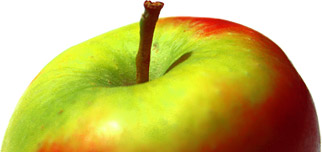Beacon was one of the first apples released by the University of Minnesota, which has become a leading center for the development of apple varieties able to withstand extreme winter cold. Beacon is cold-hardy down to USDA Zone 3.
It is an attractive red apple, and useful as one of the few cold-hardy early-season apples. However the flavor is indifferent.
USDA identification images for Beacon
The identification paintings in the USDA Pomological Watercolor Collection span the years 1886 to 1942.
Citation: U.S. Department of Agriculture Pomological Watercolor Collection. Rare and Special Collections, National Agricultural Library, Beltsville, MD 20705.
Parents and other ancestors of this variety
Visitor reviews
- 07 Jun 2019 MI, United StatesThe Beacon apple is very good fresh eating and excellent for baking..The tree produces a large quantity of medium to large red apples.
- 27 Sep 2013 WASHINGTON, United StatesToo bad Beacon seems to do poorly in the UK. I ate a bag of them grown in NE Washington state, USA, and picked fresh in September, 2013: flavor has nice sweet/tart balance with aromas of lilac and Sweet Allysum. Fascinating and delicious!
- 01 Jan 2010 United KingdomStarter post
Tree register
United States
- Becky Liegl in Waupaca, WI/WAUPACA
- Brooke Knisley in Madelia, MINNESOTA
- Joel Howie in Canton, NEW YORK
- Jon in Bridgeport, CT
- Karl Schmidt in Estelline, SD
- Rory Mcgregor in Mapleton,, MN
- Shirley Morelli in Northport, WA
- Stephan Orchard in Westfield, INDIANA
- Steven Holman in Skandia, MI
United Kingdom
- Dr Mairi Rennie in Petersfield, WEST SUSSEX
Russia
- Ann in Manturovo, KOSTROMA OBLAST
Spring blossom records for this variety
2019 season
- 11th June 2019 - tree owned by Steven in Skandia, United States
2018 season
- 28th May 2018 - tree owned by Steven in Skandia, United States
2017 season
- 6th June 2017 - tree owned by Steven in Skandia, United States
Record your blossom dates in our Fruit Tree Register - more >>.
Harvest records for this variety
2018 season
- 2nd week August 2018 - tree owned by Brooke in Madelia, United States
Origins
- Species: Malus domestica - Apple
- Parentage: (Malinda x Duchess of Oldenburg) x (Malinda x Tetofsky)
- Originates from: Minnesota, United States
- Introduced: 1936
- Developed by: Minnesota Agricultural Experiment Station (University of Minnesota)
- UK National Fruit Collection accession: 1960-056
Identification
- Country of origin: United States
- Period of origin: 1900 - 1949
- Fruit colour: Red
- Flower colour: White
- Leaf colour: Green
- Annual cycle: Deciduous
- Developer: University of Minnesota
Using
- Picking season: Early
- Keeping (of fruit): 1 week
- Flavour quality: Average
- Flavour style (apples): Sharper
- Cropping: Good
- Fruit persistence: Normal ripening
- Food uses: Eating fresh
- Picking period: early September
- Wildlife: RHS Plants for Pollinators
Growing
- Gardening skill: Average
- Flowering group: 4
- Pollinating others: Average
- Ploidy: Diploid
- Vigour: Average vigour
- Bearing regularity: Regular
- Fruit bearing: Spur-bearer
- Self-fertility: Not self-fertile
Climate
- Cold hardiness (USDA): Zone 5 (-29C)
- Cold hardiness (USDA): Zone 6 (-23C)
- Cold hardiness (USDA): Zone 7 (-18C)
- Cold hardiness (USDA): Zone 8 (-12C)
- Cold hardiness (USDA): Zone 9 (-7C)
- Cold hardiness (USDA): Zone 10 (-1C)
- Climate suitability: Temperate climates
- Summer average maximum temperatures: Cool ( 20-24C / 68-75F)
Other qualities
- Disease resistance: Average
- Cedar apple rust: Some susceptibility
- Fire blight: Very susceptible
Where to buy fresh fruit
The following orchards grow Beacon:
United States
Iowa
- Appleberry Orchard, Donnellson
- Apples on the Avenue, Nashua
- Wilson's Orchard, Iowa City
Massachusetts
- Brook Farm Orchard, Ashfield
Minnesota
- Aamodt's Apple Farm and Bakery, Stillwater
- Center Creek Orchard, Fairmont
- Cider Flats Apple Orchard, Hinckley
- Fischer's Croix Farm Orchard, Hastings
- J.Q. Fruit Farm, Princeton
- Montgomery Orchards, Montgomery
- Nelson's Apple Farm, Webster
- Sogn Valley Orchard, Dennison
- Southwind Orchards, Dakota
- Two Fruit's Fruits, Hinckley
Pennsylvania
South Dakota
- Krause Family Orchard & Nursery Inc., Glenham
Wisconsin
- Silver Creek Orchards, Merrill
References
- Cedar-Apple Rust
Author: Stephen Vann, University of Arkansas, Division of Agriculture (FSA7538)
Rated as susceptible - control usually needed where CAR is prevalent.

